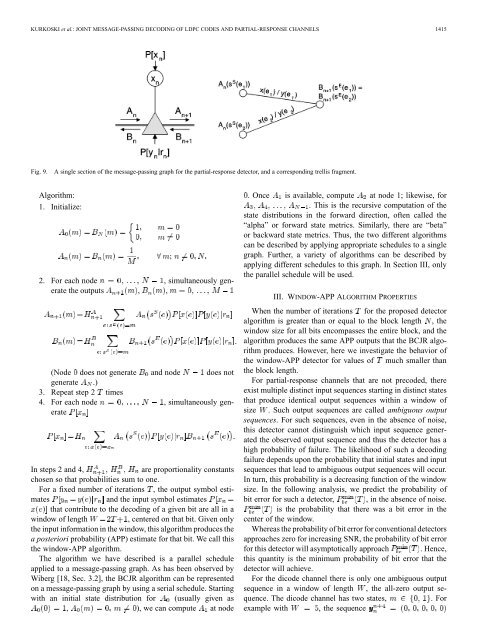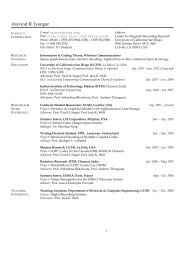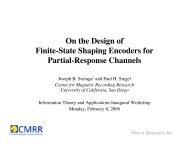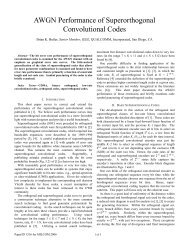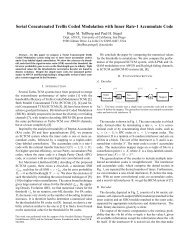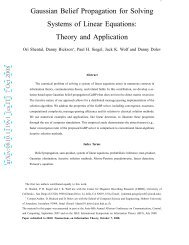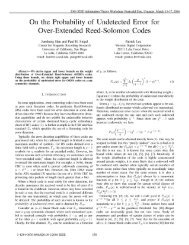Joint message-passing decoding of LDPC codes and ... - CiteSeerX
Joint message-passing decoding of LDPC codes and ... - CiteSeerX
Joint message-passing decoding of LDPC codes and ... - CiteSeerX
You also want an ePaper? Increase the reach of your titles
YUMPU automatically turns print PDFs into web optimized ePapers that Google loves.
KURKOSKI et al.: JOINT MESSAGE-PASSING DECODING OF <strong>LDPC</strong> CODES AND PARTIAL-RESPONSE CHANNELS 1415<br />
Fig. 9.<br />
A single section <strong>of</strong> the <strong>message</strong>-<strong>passing</strong> graph for the partial-response detector, <strong>and</strong> a corresponding trellis fragment.<br />
Algorithm:<br />
1. Initialize:<br />
2. For each node , simultaneously generate<br />
the outputs , ,<br />
(Node does not generate <strong>and</strong> node does not<br />
generate .)<br />
3. Repeat step 2 times<br />
4. For each node , simultaneously generate<br />
In steps 2 <strong>and</strong> 4,<br />
are proportionality constants<br />
chosen so that probabilities sum to one.<br />
For a fixed number <strong>of</strong> iterations , the output symbol estimates<br />
<strong>and</strong> the input symbol estimates<br />
that contribute to the <strong>decoding</strong> <strong>of</strong> a given bit are all in a<br />
window <strong>of</strong> length , centered on that bit. Given only<br />
the input information in the window, this algorithm produces the<br />
a posteriori probability (APP) estimate for that bit. We call this<br />
the window-APP algorithm.<br />
The algorithm we have described is a parallel schedule<br />
applied to a <strong>message</strong>-<strong>passing</strong> graph. As has been observed by<br />
Wiberg [18, Sec. 3.2], the BCJR algorithm can be represented<br />
on a <strong>message</strong>-<strong>passing</strong> graph by using a serial schedule. Starting<br />
with an initial state distribution for (usually given as<br />
, ), we can compute at node<br />
. Once is available, compute at node 1; likewise, for<br />
. This is the recursive computation <strong>of</strong> the<br />
state distributions in the forward direction, <strong>of</strong>ten called the<br />
“alpha” or forward state metrics. Similarly, there are “beta”<br />
or backward state metrics. Thus, the two different algorithms<br />
can be described by applying appropriate schedules to a single<br />
graph. Further, a variety <strong>of</strong> algorithms can be described by<br />
applying different schedules to this graph. In Section III, only<br />
the parallel schedule will be used.<br />
III. WINDOW-APP ALGORITHM PROPERTIES<br />
When the number <strong>of</strong> iterations for the proposed detector<br />
algorithm is greater than or equal to the block length , the<br />
window size for all bits encompasses the entire block, <strong>and</strong> the<br />
algorithm produces the same APP outputs that the BCJR algorithm<br />
produces. However, here we investigate the behavior <strong>of</strong><br />
the window-APP detector for values <strong>of</strong> much smaller than<br />
the block length.<br />
For partial-response channels that are not precoded, there<br />
exist multiple distinct input sequences starting in distinct states<br />
that produce identical output sequences within a window <strong>of</strong><br />
size . Such output sequences are called ambiguous output<br />
sequences. For such sequences, even in the absence <strong>of</strong> noise,<br />
this detector cannot distinguish which input sequence generated<br />
the observed output sequence <strong>and</strong> thus the detector has a<br />
high probability <strong>of</strong> failure. The likelihood <strong>of</strong> such a <strong>decoding</strong><br />
failure depends upon the probability that initial states <strong>and</strong> input<br />
sequences that lead to ambiguous output sequences will occur.<br />
In turn, this probability is a decreasing function <strong>of</strong> the window<br />
size. In the following analysis, we predict the probability <strong>of</strong><br />
bit error for such a detector, , in the absence <strong>of</strong> noise.<br />
is the probability that there was a bit error in the<br />
center <strong>of</strong> the window.<br />
Whereas the probability <strong>of</strong> bit error for conventional detectors<br />
approaches zero for increasing SNR, the probability <strong>of</strong> bit error<br />
for this detector will asymptotically approach . Hence,<br />
this quantity is the minimum probability <strong>of</strong> bit error that the<br />
detector will achieve.<br />
For the dicode channel there is only one ambiguous output<br />
sequence in a window <strong>of</strong> length , the all-zero output sequence.<br />
The dicode channel has two states,<br />
.For<br />
example with , the sequence


